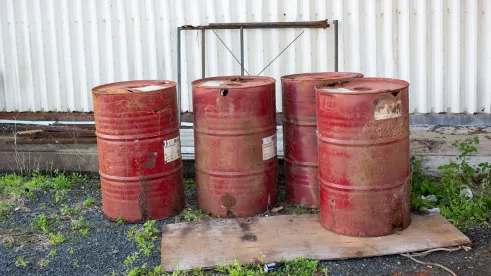In a rare move, on May 3, 2023, the U.S. Environmental Protection Agency (EPA) announced that it was granting enforcement discretion to the nuclear industry and its suppliers to resume using wire and cable intended for use in nuclear power facilities that contain a flame retardant otherwise largely banned under the Toxic Substances Control Act (TSCA). This action allows nuclear power plants that have been unable to reopen after shutdowns to start up again once they receive their cables. It also allows suppliers to that industry to install such cables into equipment intended for nuclear power plants. But besides its importance to that industry, this action should be a cautionary tale for all other industries that depend on chemicals, directly or indirectly – TSCA has teeth, and its reach extends to all kinds of machinery, equipment, appliances, products, and industries. Heightened vigilance for TSCA developments is now critical.
Why Did EPA Grant Enforcement Discretion?
Statutory and Regulatory Changes
When Congress amended TSCA in 2016, it added section 6(h), which directed EPA to restrict or ban certain persistent, bioaccumulative, and toxic chemicals (PBTs). One of the PBTs to be restricted was phenol, isopropylated phosphate (3:1), known at PIP (3:1). Another was decabromodiphenyl ether, known as decaBDE.
This legislative change should have been a signal to all affected persons that PIP (3:1) and decaBDE were on their way out. Representatives of the automobile and aerospace industries sought meetings with EPA to let it know that they would need to use both chemicals for years to come. In 2018, one company that supplied the nuclear industry, RSCC Wire & Cable, LLC (RSCC), informed EPA that it used decaBDE as a flame retardant in its critical safety-related cables for the nuclear industry, but that it had been working since 2016 to identify and qualify an alternative flame retardant that would meet the stringent requirements for nuclear use.
In 2019, EPA published a proposed rule to ban almost all uses of both chemicals. It proposed extended compliance deadlines for the automotive and aerospace industries for both chemicals, but none for the nuclear industry. In 2020, RSCC followed up with EPA and indicated that it, too, would need more time to identify and qualify its decaBDE alternative.
The final rule, published January 6, 2021, added an extended compliance date for use of decaBDE in wire and cable for use in nuclear facilities until January 6, 2023, as well as more extended compliance dates for the automotive and aerospace industries. EPA also adopted a similar rule for PIP (3:1).
Request for Extension
During the next two years, RSCC continued what was eventually a 7-year R&D process to identify and qualify its alternative to decaBDE. However, by October 2022 it became apparent that the required qualification testing would not be completed by January 6, 2023. It asked EPA for a further extension.
When January 6, 2023 arrived, EPA still had not agreed to or rejected RSCC’s request for an extension. RSCC stopped all shipments and production operations.
On behalf of RSCC, Beveridge & Diamond wrote to the Office of Pollution Prevention and Toxics (OPPT, the office implementing TSCA within the Office of Chemical Safety and Pollution Prevention (OCSPP)) on January 13, 2023, asking for an extension of the compliance date and enforcement discretion. The letter explained that without an extension or enforcement discretion, many nuclear power facilities already in maintenance shutdowns or with shutdowns scheduled would be unable to restart without receiving decaBDE-containing wire and cable, or equipment containing such wire and cable, with potentially serious impacts on the national supply of electricity. The letter cited the situation with PIP (3:1), where OCSPP had requested the Office of Enforcement and Compliance Assurance (OECA) to grant enforcement discretion, and OPPT had conducted rulemakings to extend the PIP (3:1) compliance deadline. Several nuclear industry trade groups and individual equipment suppliers containing the RSCC cables wrote letters supporting the January 13 letter. For example, the Nuclear Utility Group on Equipment Qualification advised EPA on January 19:
"[W]ithout OPPT approval of a further extension or enforcement discretion, RSCC and other manufacturers and suppliers of wire and cable to nuclear facilities will be unable to fulfill existing and expected future orders from nuclear power plants or to supply wire and cable in emergent situations. Multiple nuclear power plants may have to go offline, possibly for several months or longer, due to the unavailability of replacement cables or wiring (which can be used in multiple equipment items), or other nuclear safety related equipment items that do contain decaBDE."
On January 26, 2023, OPPT denied the extension request and declined to ask OECA for enforcement discretion. However, it suggested that RSCC reach out to OECA directly, “to discuss if there are enforcement settlement response options available.”
Denial of Extension Request and Next Steps
During the subsequent discussions between RSCC and OECA, RSCC completed the qualification of its alternative to decaBDE. Since February 27, 2023, RSCC has been able to produce cables without decaBDE for nuclear industry use.
Over the next few months, the Nuclear Regulatory Commission (NRC) and EPA had multiple discussions. RSCC’s discussions with OECA led to two results. One was a consent agreement and final order (CAFO) issued to RSCC. It included a penalty for violating the decaBDE rule, because, as part of its standard manufacturing process, RSCC had exported to Canada in-process cables containing decaBDE for a processing step and reimported them. Under the decaBDE rule, RSCC’s manufacture of wire and cable containing decaBDE was considered “processing” and “distribution” of decaBDE, which the rule’s extended compliance date permitted. However, the act of reimporting something it had exported for processing (with no change in the decaBDE content) was actually considered “manufacturing” decaBDE, which was not permitted under the nuclear industry’s extended compliance date.
The CAFO included its own grant of enforcement discretion to RSCC, allowing it to resume production and distribution of cables containing decaBDE for up to five years. Despite RSCC having qualified, and initiated the manufacture of, its decaBDE-free alternative, OECA asked RSCC to resume its decaBDE manufacturing activities due to significant concerns that other nuclear industry suppliers and nuclear power plants might need additional time to transition to cables without decaBDE.
The other result of the discussions was OECA’s Enforcement Statement granting enforcement discretion for the nuclear industry and their suppliers until September 30, 2024, or the effective date of a final rule extending the compliance date for cables used in the nuclear industry, whichever comes first. It allows all other nuclear industry suppliers to manufacture wire and cable, install decaBDE-containing cables in equipment and ship the equipment to nuclear facilities without fear of EPA enforcement penalties. It also continues to allow nuclear facilities to install and use both decaBDE-containing cables and equipment containing them.
Thus, these two actions allowed suppliers to resume production and distribution of nuclear industry equipment, and allowed nuclear power plants that had shut down for maintenance or were scheduled to do so to complete their maintenance and then start up again – results that had been stalled for months.
Lessons from This Situation
Other industries should learn from this experience.
1. TSCA applies to almost all industries. The nuclear industry as a whole had not considered TSCA relevant to its operations; instead, its regulatory focus was on NRC and its requirements. It now recognizes that TSCA can be extraordinarily relevant. Similarly, many industries outside the chemical industry had not considered TSCA to affect their operations, but found with PIP (3:1) that they, too, could be disrupted by EPA action under TSCA. TSCA does not apply to pesticides or materials regulated by the Food and Drug Administration, but other industries must be aware that TSCA may impact them.
2. EPA has authority under TSCA to ban or severely restrict chemicals used by many industries. DecaBDE had been used in nuclear industry equipment for decades. PIP (3:1) had also been used for many years in multiple industries as well. Under section 6(a) of TSCA, EPA may prohibit or restrict the manufacture, processing, distribution, use (or particular uses), and disposal of chemicals found to present an unreasonable risk. For example, EPA recently proposed to ban all uses of methylene chloride for 44 conditions of use. See our alert here.
3. EPA can and does regulate chemicals in equipment. Much of the TSCA relevance comes from EPA’s authority to ban or restrict chemicals contained in articles. EPA defines “article” in 40 C.F.R. § 751.403 and elsewhere to mean a manufactured item:
(1) Which is formed to a specific shape or design during manufacture,
(2) Which has end-use function(s) dependent in whole or in part upon its shape or design during end-use, and
(3) Which has either no change of chemical composition during its end use or only those changes of composition which have no commercial purpose separate from that of the article, and that result from a chemical reaction that occurs upon end use of other chemical substances, mixtures, or articles; except that fluids and particles are not considered articles regardless of shape or design.
This broad term can include everything from refrigerators to computers to tractors to heavy equipment. For many years, EPA did little to regulate chemicals in articles, despite having the authority to do so. In recent years, however, EPA rules have applied to articles containing chemicals of concern to EPA, including those for PIP (3:1) and decaBDE. EPA recently proposed to ban all remaining uses of asbestos in articles. See our alert here.
4. All industries should monitor TSCA rulemaking proposals and submit comments where appropriate. Out of the entire nuclear industry, RSCC was the only entity to submit comments to EPA on its proposed ban of decaBDE. In pleading for relief from that ban in February 2023, the Nuclear Energy Institute (NEI) acknowledged.
"Unfortunately, NEI was not aware of and, thus, did not participate in the EPA’s decaBDE rulemaking necessitating our presentation of additional information now. Based upon our interactions with the industry to date, it appears that virtually all of the nuclear power industry, generators as well as suppliers, were also unaware of and, therefore, did not participate in the rulemaking. As a result, the compliance date specific to nuclear generation facilities included in the final rule was not informed by a full understanding of the potential impacts on the nuclear supply chain and, ultimately, on our generation facilities."
Just as it did with respect to the industries who did not participate in the PIP (3:1) rulemaking, EPA chastised those who failed to participate in the decaBDE rulemaking, saying:
"This issue was exacerbated by a lack of effective communication by the nuclear power sector with EPA despite multiple opportunities to comment on EPA’s rulemaking decisions."
Other industries should now recognize the critical need to inform EPA of their uses of chemicals proposed for bans or restrictions and their ability – or inability – to meet phase-out timetables or to qualify alternative chemicals for use in their industries. For all industries affected by decaBDE or PIP (3:1), it will be important to participate in the proposed rulemaking expected in November 2023 to review those rules.
5. Under TSCA, importation of equipment counts as the manufacture of the chemicals in that equipment. Under section 3(9) of TSCA, “manufacture” includes importation. RSCC had lawfully purchased decaBDE domestically, incorporated it into partially-completed cables, and then exported those cables for a necessary processing step. When it subsequently imported those cables, it became a manufacturer for TSCA purposes of the same decaBDE, at a time when manufacture of decaBDE was no longer allowed. Similarly, importers of equipment containing PIP (3:1) learned that they were considered manufacturers of that chemical. These painful lessons exemplify the broad reach of TSCA to all importers of articles.
6. Supply chains are often complex, creating challenges to finding whether a rule applies. A producer of complex equipment for the nuclear industry advised EPA that it had been unaware that decaBDE was present in the cables it purchased. Purchasers of articles may have difficulty learning from suppliers whether a particular chemical is used in purchased articles, particularly if the supply chains for the components of those articles are complex or involve imports. Industries potentially affected by the PIP (3:1) rule also found that complex supply chains and foreign suppliers made determining whether that chemical was present in their imported articles challenging. Yet EPA has generally been unsympathetic to that complaint. In the decaBDE final rule’s preamble, it declared:
"EPA does not believe that Congress intended, through the article provisions incorporated into the TSCA amendments, to absolve importers of the duty to know what they are importing. Importers can and should take steps to determine whether the articles they are importing contain chemicals that are prohibited or restricted."
Thus, once EPA targets a chemical that may be in purchased articles (whether or not imported), purchasers of those articles should consider engaging in outreach with their suppliers, and the sooner the better. For example, they may ask for certification that a chemical of concern is not present in the equipment being supplied.
7. The time needed for identifying and qualifying substitutes is critical information for EPA. Qualification of substitute chemicals can take years, but without adequate information, EPA will assume that the times it proposes for phase-outs or restrictions of chemicals are feasible. RSCC had expected that it would have qualified a substitute for decaBDE by the time EPA’s ban took effect, but it missed that compliance date by a matter of weeks – which led to a crisis. Moreover, qualification of a substitute by a direct user of a chemical may mean that downstream users of equipment containing the substitute may feel the need to qualify their own equipment, as noted by OPPT in its request to OECA for enforcement discretion:
"However, once the wire and cable with the alternative insulation is qualified, OCSPP understands that each component part that contains the alternative wire and cable will also need to undergo its own qualification testing process. The NRC has informed EPA that the environmental qualification process can take licensees and vendors 2 to 3 years to qualify a component and an additional six months to a year may be required for licensees and vendors to establish adequate inventory prior to being able to ship a component to a nuclear power plant."
Accordingly, affected industries need to submit to EPA – on a timely basis – information on how long they will need to move beyond use of an EPA-targeted chemical.
8. Earlier is better for providing information to EPA. For both the PIP (3:1) rule and the decaBDE rule, trade associations and companies in the automotive and aerospace industries met with EPA. They provided information well before the publication of a proposed rule. RSCC did this to a limited extent as well. This served those industries well, as EPA included extended compliance deadlines for those industries in the proposed rules. That allowed those industries to comment further on those deadlines, rather than plead with EPA to add new extended compliance dates. With the expected November 2023 proposed rule addressing the compliance deadlines in the PBT rules, affected industries may want to inform EPA now of their views on what those compliance deadlines should be.





 />i
/>i
